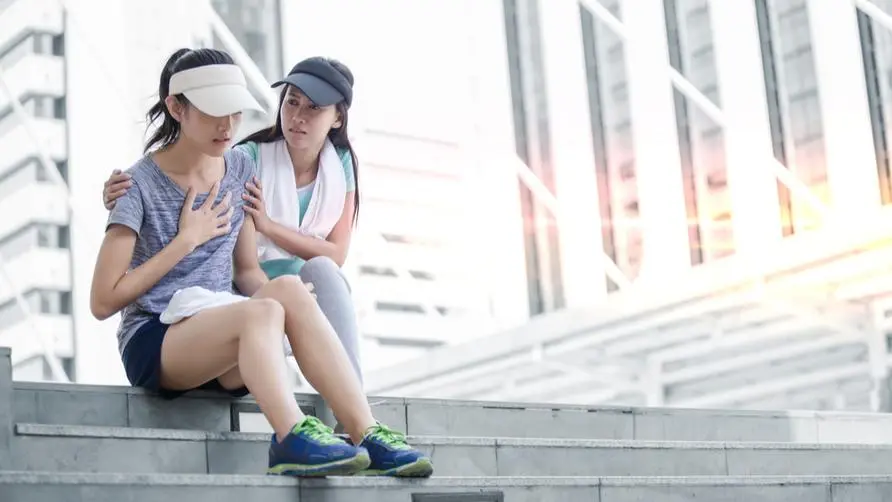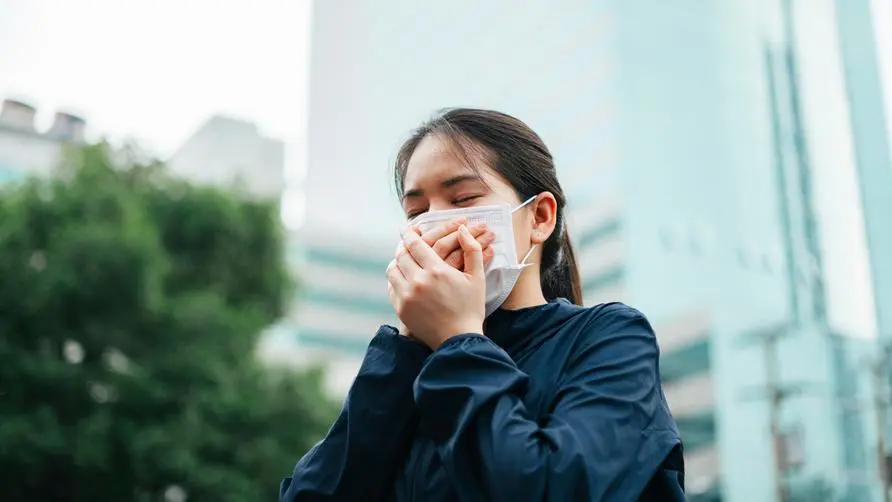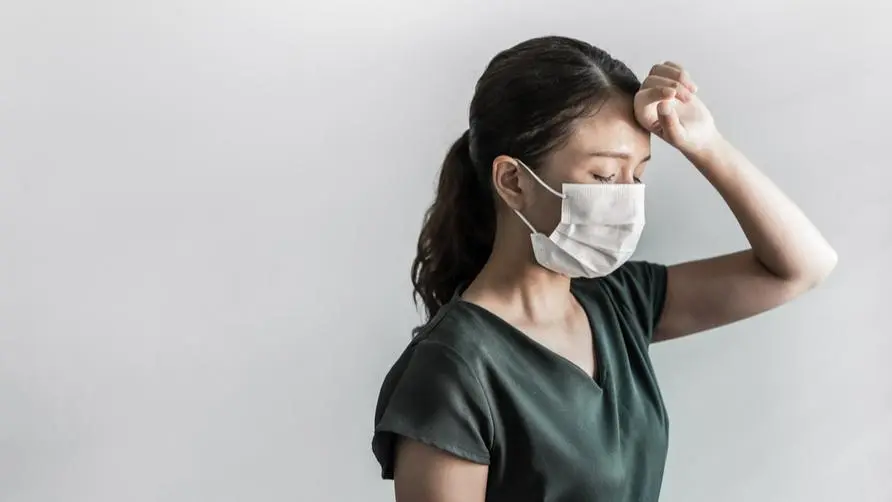After being diagnosed, I am easily out of breath and unable to walk far! "Cardiopulmonary function" affected? 2 self-examination tips for medical education

Omicron less likely to invade lungs? Is it related to the protective effect of vaccines?
Omicron pandemic, lower lung invasion rate compared with Delta? Dr. Shiji Ku, convener of the Public Affairs Group of the Taiwan Society of Chest and Intensive Care Medicine and director of the Internal Medicine Intensive Care Unit and Respiratory Care Center of National Taiwan University Hospital, said in an interview that the respiratory system can be divided into upper respiratory tract and lower respiratory tract. The upper respiratory tract includes the nasal cavity, pharynx, Larynx; lower respiratory tract generally refers to the section from the bronchi to the alveoli.
Dr. Gu Shiji pointed out that Omicron does have more obvious symptoms in the upper respiratory tract. After being infected with the epidemic, symptoms similar to severe colds are likely to occur, such as nasal congestion, runny nose, and cough. However, this does not mean that there are no cases of infringement of the lower respiratory tract, but the proportion is significantly reduced compared to last year’s Delta epidemic. The protective effect of the vaccine may also be the reason why Omicron is less likely to invade the lower respiratory tract.
Does infection increase the severity of other diseases? People with asthma and lung obstruction should be careful
Are you worried about other lung diseases if you are infected with the COVID-19 virus? Dr. Gu Shiji said that reports from various countries have shown that confirmed patients will complain of symptoms related to “long-term COVID-19”, such as fatigue, weakness in walking, easy breathing, and reduced physical strength and tolerance. However, compared with the deterioration in lung function tracking data of cases diagnosed with Delta last year, most of the lung functions of cases diagnosed with Omicron have not deteriorated significantly so far.
For people with pre-existing chronic lung diseases or those in high-risk groups, infection with the epidemic is more likely to worsen the original disease. Dr. Gu Shiji pointed out that the most affected groups in the thoracic department are mainly “asthma” and “pulmonary obstruction” (COPD). After these patients are infected with the epidemic, their symptoms almost worsen in a one-sided manner. It is like getting a severe cold and requires 3-4 weeks of medication adjustment before symptoms gradually improve.
Can viruses cause allergies? May cause poor control of autoimmune diseases
Dr. Gu Shiji said that last year’s Delta virus strain easily invaded the lower respiratory tract and lung parenchyma, causing severe alveolar inflammation and fibrosis, which in turn affected the patient’s lung capacity. The patient would become significantly more breathless when walking or doing activities. In comparison, Omicron this year mainly focuses on mild symptoms. When patients with chronic respiratory diseases are diagnosed, they will have symptoms similar to cold virus infection, and most of them need a period of medication and recuperation.
In addition, infection with the new coronavirus increases the risk of allergies. Dr. Gu Shiji pointed out that last year, it was discovered that the Delta virus strain may trigger an “immune storm” after infection. There are also cases of skin and nose allergies in some confirmed patients that were triggered after infection. Performance. Patients with autoimmune diseases such as lupus erythematosus and rheumatoid arthritis are more likely to have poorly controlled symptoms.
How to self-monitor your lung function? Blood oxygen and stair climbing 2 tips to help judge
How to pay attention to whether there are changes in lung function after diagnosis and during the recovery stage? Dr. Gu Shiji said that the blood oxygen detector is a relatively convenient tool. If the blood oxygen content fluctuates too much during static and active activities, it may be a warning signal. Taking the basic value of 95% as an example, if your blood oxygen is normal when you sit down and rest, but you start to walk quickly or climb stairs and find that your blood oxygen drops below 90% in one breath, it may mean there is a lung condition, and it is recommended to seek examination at a thoracic medicine department.
As for cardiorespiratory endurance, which can be compared with one’s own ability to climb stairs, Dr. Koo Shiji explained that it is mainly “comparing yourself with yourself.” If you could climb to the 4th floor in one breath in the past, now you need to rest when you reach the 1st or 2nd floor. Regardless of whether it is caused by muscle soreness, fatigue, or insufficient oxygen exchange function, it indicates poor exercise tolerance and may also be a sign of cardiopulmonary problems. It is recommended to seek medical examination.
Are you afraid of going out for exercise for fear of contracting the epidemic? Beware of falling into a vicious cycle of functional decline
Dr. Gu Shiji pointed out that the epidemic is still at its peak. If people are worried about the impact on their cardiopulmonary function, they can first observe themselves in the above way. In particular, some people and their elders are worried about contracting the epidemic and stop going out for exercise, which may cause a temporary decline in cardiopulmonary function. It is best to slowly adjust your work and rest and gradually increase the amount of exercise. If your physical strength and tolerance improve, don’t worry too much.
On the other hand, if you resume exercise habits after being diagnosed, but feel that your cardiopulmonary function cannot fully return to its original level, you should pay attention to whether there are other problems, or seek relevant examinations from the thoracic department or related departments as soon as possible.
Dr. Gu Shiji suggested that during the epidemic, avoid going to crowded indoor places, but the elderly and risk groups can still exercise moderately in open ventilated areas or at home, which can help maintain cardiopulmonary function and avoid falling into a vicious cycle of functional decline.
Is COVID-19 a real symptom or a psychological phenomenon? There is no consensus on what constitutes a challenge
Should we worry about the sequelae of “coronavirus” after contracting the epidemic? Dr. Gu Shiji pointed out that the epidemic in Taiwan is about 3 to 6 months slower than that in other countries. The number of cases last year was also relatively low. A large number of patients reported that the phenomenon of “growing new coronavirus” has not yet occurred. However, judging from current foreign reports, confirmed patients do complain of subjective descriptions such as easy fatigue, brain fog, and breathlessness while walking. How to define and track “long COVID-19” will be a big challenge.
Dr. Gu Shiji pointed out that foreign reports show that the incidence of COVID-19 is not necessarily related to the severity of the disease at the time of infection. People with mild symptoms may also be affected by COVID-19 in their daily life in the future. The most worrying ones are the brain, Cardiopulmonary function, endocrine and muscle problems. In the future, thoracic medicine, psychiatry, neurology and other experts must jointly formulate a definition for COVID-19, and then establish clear tracking and diagnosis and treatment benchmarks.
Dr. Gu Shiji took thoracic examination as an example. In addition to chest X-ray examination and pulmonary function test, the patient may also be asked to perform a 6-minute walk test and monitor the patient’s blood oxygen and blood pressure. If you find that you cannot walk very far during walking, or there are significant changes in blood oxygen, blood pressure, and heartbeat while walking, you can better judge that the physiological lung function is affected.
The number of people infected with the epidemic has exceeded 2 million. COVID-19 tracking should be deployed in advance
In addition, the proportion of children infected with the disease is gradually increasing, and vaccine coverage is not as popular as that of adults. Dr. Gu Shiji believes that in the future, the monitoring and tracking of COVID-19 in children after they are infected will also be the focus of the medical system.
Dr. Gu Shiji pointed out that although the government currently encourages medical centers and medical institutions to open joint tracking clinics for recovered COVID-19 patients, the number of confirmed cases has increased significantly this year, with more than 2 million people infected so far. The workload of outpatient tracking operations may be quite huge. The medical community should plan ahead to cope with the upcoming challenges.
Dr. Gu Shiji called on the competent authorities to make “advanced arrangements” and convene experts from relevant medical associations as soon as possible to discuss the diagnosis and treatment guidelines for “long COVID-19” so that they can have more adequate response measures and medical care in the face of the possible wave of sequelae. .
Further reading:





